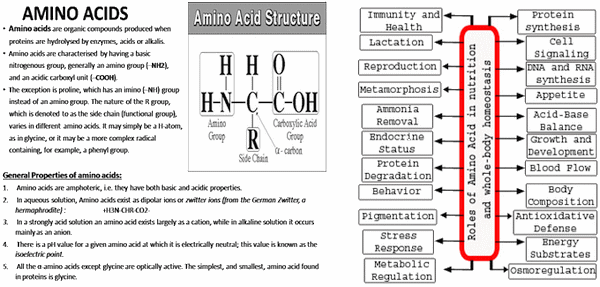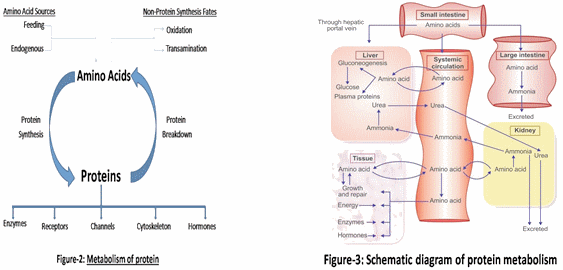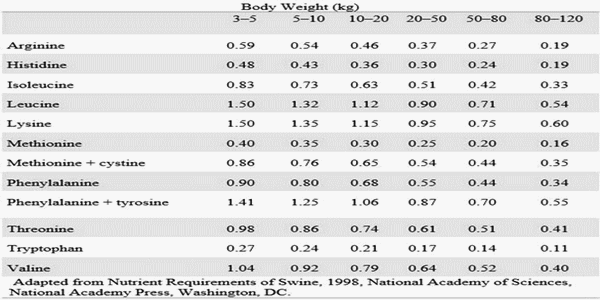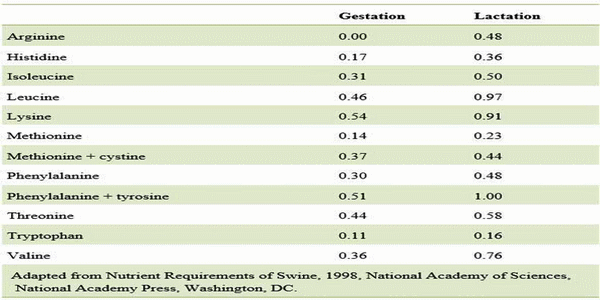The significance of Amino Acids in the animal diet with special emphasis on pig health
Published: May 4, 2017
By: Dipankar Paul, Kulajit Kalita and Sanjib Borah.
/ Lakhimpur College of Veterinary Science, Assam Agricultural University, Joyhing, North Lakhimpur, Assam-787051, India.
Unfortunately, the roles of amino acid (AA) in nutrition and metabolism have long been neglected, until the conclusion that the AA glutamine is important for intestinal mucosal integrity and AA arginine is a prerequisite for maximum embryonic development and optimum neonatal growth (Wu, 2010). Traditionally, Amino acids (AA) were classified as nutritionally essential or nonessential for animals and humans based on nitrogen balance or growth. Nutritionally essential AA (EAA) or indispensable AA are so termed because the carbon skeleton of the AA cannot be synthesized in the biological system, and thus must be supplied through the diet of farm animals. Out of total twenty-two amino acids for monogastric animals, the pigs require only ten EAA (Arginine, Methionine, Histidine, Phenylalanine, Isoleucine, Threonine, Leucine, Tryptophan, Lysine and Valine). Practically, among essential AA (EAA), much emphasis has been placed on lysine, methionine, leucine and tryptophan. In comparison to EAA, the non-essential AA (NEAA) or dispensable AA are those AAs that are synthesized de novo within the body (or biological system) and no need to provide through the diet. However, the studies on animal show that some of the traditionally classified NEAA (e.g. arginine, glutamine and glutamate) play very important roles in multiple signaling pathways, regulation of gene expression, nutrient metabolism, immunity and oxidative defense (Brasse-Lagnel et al, 2009; Yao et al, 2008). Amino acids are building blocks of protein. Besides serving as building blocks for proteins, AAs have multiple regulatory functions in cells (Figure-1: Roles of AA in nutrition and whole-body homeostasis).

Hence, a deficiency of an AA (either EAA or NEAA) impairs whole-body homeostasis by impairing the genetic codes for production of other essential molecules (e.g. enzymes, hormones, immunoglobulins, etc) within the biological system specifically in pigs. Remarkably, supplementation of a specific AA (e.g. arginine and glutamine) to a conventional or ordinary diet that observed maximum growth potential in young animals (Wu, 2009; Wu et al,2004 ) and prevent diseases starting from intrauterine growth retardation, obesity, necrotic lesions in body to enterocolitis in both animals and humans (Wu et al,2009).
Nowadays, “ideal protein concept or profile” is followed by growing animals. The ideal protein is a concept in which the amino acids pattern (defined as ideal ratios of EAAs to lysine) that maximizes growth, nitrogen retention or other response criterion. In this concept, all essential amino acids are equally limiting for performance, just covering the requirements for all physiological functions. Lysine has traditionally been used as a reference for this concept because it is the first limiting amino acid for growth in pigs.
General effects of AA deficiency in livestock
Inadequate supply of AA in young animals results in lowered body weights. In young animals, there is reduced appetite, lowered feed intake, less feed efficiency, reduced nitrogen retention, lack of muscle development, inferior growth rate and prolonged time to reach maturity. But, in the case of mature animals, there is a loss of weight, and reduced milk or egg production(in poultry). In both young and mature animals there is a drop in hemoglobin (Hb) concentration, packed cell volume (PCV), total serum protein including serum albumin. In the late stages, there is edema associated with hypoproteinemia.
Clinical signs of amino acid imbalances and deficiencies in swine
The most important and primary sign of AA imbalance is generally a reduction in feed intake which leads to increase feed wastage, defective growth and general unthriftiness in pigs. A pig can tolerate high intake of protein without any ill effects (sometimes mild diarrhea may occur), but the large intakes of individual AA may result in some negative effects like toxicity, AA antagonism, and imbalance.
Limiting amino acids of pig
If a diet is not sufficient in any essential amino acid, the protein synthesis cannot proceed beyond the rate at which that amino acid is available. This is called a “limiting amino acid”. Another way of describing a limiting AA is that EAA present in a feed in the least (or critical) amount relative to the requirement of pigs. There are various sets of recommendations which provide the requirements of AA in animals like NRC (National Research Council), USA. The requirements vary depending on the species and age of animals. AA should be supplied either in the form of protein or crystalline amino acids in the feed to meet the requirements. High quality protein contains all of the essential amino acids at acceptable levels. But a poor quality protein is deficient in one or more of the AA. Hence, some of the essential amino acids may be deficient due to use of variable quality protein in pig diets. These AAs are called the limiting ones and in most cases, lysine is the most likely, followed by methionine and both are often added to diets routinely. If the diet is deficient in one or more of these essential AA then protein synthesis will only continue to the level associated with the first limiting amino acid. By comparing requirements and the actual amino acids present in the feed, the order of ‘limiting amino acids’ is estimated. The orders of limiting amino acids in pig and broiler feeds, composed of corn (or wheat) and soybean meal, are listed below (Table 1):
Table 1: Limiting amino acids in cereal grains used for pig diet.

The crystalline amino acids should be added to feed in the order of limiting amino acids when the protein content of the feed is inadequate. Nowadays, with a more economic supply of L-Threonine and L-Tryptophan available, use of amino acids has entered a new era, in which the use of second and third limiting amino acids is taking off. The limiting AA present in the feed source for pigs are listed in the following table (Table 2):
Table 2: Limiting amino acids in some cereal grain used in pig diets.

Primary sources of Amino acids in pig diet
The swine feed contains vegetable and animal sources of AA. The common vegetable sources are soybean meal, cottonseed meal, or corn gluten meal. And animal sources are fish meal, meat and bone meal, dried skim milk. Soybean is the best-known of the vegetable sources of AA and fishmeal is an animal source of AA. Soybean is the only plant protein that compares with animal protein in terms of quality of amino acid content and ratio and can be used as the only protein source in most of the pig diets.
Metabolism of AA
Amino acids present in the feedstuffs (either vegetable or animal sources of AA) are mainly found in complete protein chains. During the process of digestion, these protein chains are broken down or hydrolyzed by enzymes, acids or alkalis in the gastrointestinal tract to release individual AA (or short chains of them). These are then absorbed into the bloodstream and used to form new proteins that will be useful to the animal. The major metabolic fate of amino acids in the gut is considered to be their incorporation into cellular proteins. Metabolism of proteins is given in the form of a schematic diagram (Figure-2 & Figure-3).

Alternative AA sources can be fed to pigs
Soybean is the best-known of the vegetable sources of AA used in swine diets. But, substitutes for soybean meal in swine diets as a protein source should appear to be economical compared to soybean meal, comparable chemical composition to ensure optimum pig performance.
1. Cottonseed meal
The production of cottonseed meal ranks second as compared to soybean meal. But it is used in limited quantity due to its deleterious effects produced by the residual free gossypol (a toxic substance produced by fungi) found in the pigment glands of the seed. Cottonseed meal is fairly high in protein, but low in lysine and tryptophan. It is recommended that cottonseed meal replaces not more than 50% of the protein supplement or soybean meal in the diet so that the inclusion level should not exceed 0.01% of free gossypol concentration in the diet for proper performance of pigs. But the pig performance begins to be reduced at gossypol concentrations of 0.04% of the diet. However, gossypol-free (solvent-extracted) cottonseed meal can be used to replace 75% of the protein source in growing-finishing pig diets when balanced on a lysine basis.
2. Sunflower meal
Sunflower meal is produced by extraction of the oil from sunflower seeds. It contains high fiber content (22-24%) and should be used in limited quantities in pig diets. Although Sunflower meal is high in sulfur-containing amino acids (cysteine and methionine) in comparison to soybean meal, but it is relatively low in lysine. Soft pork will produce due to the high level of oil (especially unsaturated fatty acid content) is present in the sunflower meal. It is recommended that sunflower meal may replace up to 25% of the protein for growing-finishing pig diets.
3. Meat and Bone meal
The meat by-products also can be used in pig diets. Usually, meat and bone meal is an excellent source of calcium and phosphorus. However, it is often very low in methionine and tryptophan. Since there is considerable variation in the type and quality of the raw materials used, there is potential for greater variation in the quality of meat and bone meal. However, use of excessive heat during the processing of meat and bone meal may reduce its digestibility and value as a protein source (i.e. availability of the amino acids, particularly lysine). Hence, it is recommended that the inclusion level of meat and bone meal should not exceed 25% of the protein supplement.
4. Raw Soybeans
However, raw soybeans contain higher amounts of trypsin inhibitors that block/inhibits normal protein digestion in the pigs. Raw soybeans, especially weather damaged or low test-weight beans, are frequently used as attractive alternatives to the pig diets. As the pig becomes older, its susceptibility to trypsin inhibitor decreases. Therefore, raw soybeans can be added only in gestation diets without any adverse effects. If raw soybeans are to be used in young pigs diet, it is necessary to heat the beans before feeding to inactivate the trypsin inhibitors.
5. Rapeseed meal
Rapeseed meal is a by-product of vegetable oil processing from rapeseed. It is also known as Canola meal. Rapeseed meal contains 35-40% crude protein. It has less lysine content but more sulfur-containing amino acids as compare to soybean meal. Some varieties of rapeseed contain high levels of a toxic compound, glucosinolate, which affect normal thyroid functions. It is recommended that rapeseed meal can be added to replace up to 50% of the protein from soybean meal in growing-finishing pig and sow diets without adversely affecting performance.
Dietary AA Requirements (%) of Growing Pigs Allowed Ad Lib Feed (90% dry matter) is listed in the table below

Dietary Nutrient Requirements (%) of Gestating and Lactating Sows (90% dry matter) is listed in the following table

Environmental nitrogen contamination
Environmental nitrogen contamination attributed to the livestock industry arises from the fact that animal efficiency for converting feed into animal protein is less than 100%. Though swine are among the most efficient, they convert only 35 to 45% of ingested dietary nitrogen to meat. It has been reported that reducing dietary protein by four percentage units with the addition of lysine, methionine, threonine, and tryptophan results in a marked reduction in urinary nitrogen excretion from growing-finishing pigs (Carter et al., 1996). Effective reduction of nitrogen excretion in swine production requires an examination of the origin of the problem, namely nitrogen (protein) intake.
Nitrogen excretion in pigs may be reduced by
1. Phase feeding to provide a series of diets closely matching the pig's requirements.
2. Utilization of commercially available amino acids combined with reduced protein levels to provide better-balanced diets. Formulating diets based on ideal protein concept would be useful.
3. Reducing nitrogen excretion via nutritional means may provide a less expensive solution on a long term basis.
Use of synthetic amino acids in pig Diet
Synthetic amino acids can be added to replace a portion of protein in the pig diets to meet the amino acid requirement. The use of synthetic amino acids in the diet can reduce feed costs and maintain pig performance. Synthetic Lysine and Synthetic methionine are most commonly used in pig diets. The studies have demonstrated that supplemental lysine can reduce the amount of soybean meal needed in swine diets. The most common source of synthetic lysine is L-lysine monohydrochloride, which is 78 percent lysine. The increasing availability of synthetic amino acids continues to make their use a more economically viable option for swine diets.
Advantages of use of synthetic amino acids in pig diet
Use of synthetic amino acids reduces the crude protein level of the diet. Example: addition of supplemental lysine can reduce the amount of soybean meal required in the pig diets i.e. synthetic lysine can reduce the crude protein level of the diet without affecting performance of pigs. Synthetic lysine is almost always an economical addition to swine diets, but prices vary between synthetics and one may be economical while another may not at a given price. Nitrogen excretion and ammonia emissions are decreased as greater levels of synthetic amino acids are added in the diet and relative crude protein level also decreases. Therefore, the net energy level of the diet increases as grain and synthetic amino acids replace protein sources in the diet.
Disadvantages of use of synthetic amino acids in pig diet
Most of the synthetic amino acids are available in dry or liquid forms. Some instruments like pumps and metering devices are required to use liquid forms of synthetic amino acids. However, the dry forms are free and do not pose great handling concerns and are relatively stable during their storage. Because of the precision required in dry form with low inclusion levels of some amino acids, mixing equipment and accurate scales are needed for their use.
References
Brasse-Lagnel C, Lavoinne A, Husson A. 2009.Control of mammalian gene expression by amino acids, especially glutamine. FEBS J. 276:1826–44.
Carter, S.D. et al. 1996. J. Anim. Sci. 76(Suppl. 1):170.
Wu G, 2010. Functional amino Acids in growth, reproduction, and health.Advances in Nutrition. 1: 31-37
Wu G . 2009. Amino acids: metabolism, functions, and nutrition. Amino Acids. 37:1–17.
Wu G, Bazer FW, Davis TA, Kim SW,Li P, Rhoads JM, Satterfield MC, Smith SB,Spencer TE, 2009. Arginine metabolism and nutrition in growth, health and disease. Amino Acids.37:153–68.
Wu G, Knabe DA, Kim SW. 2004. Arginine nutrition in neonatal pigs. J. Nutr. 134:S2783–90.
Yao K, Yin YL, Chu WY, Liu ZQ, Deng D, Li TJ, Huang RL, Zhang JS, Tan BE,2008. Dietary arginine supplementation increases mTOR signaling activity in skeletal muscle of neonatal pigs. J Nutr. 138:867–72.
Related topics:
Authors:
Assam Agricultural University
Recommend
Comment
Share

Would you like to discuss another topic? Create a new post to engage with experts in the community.








.jpg&w=3840&q=75)